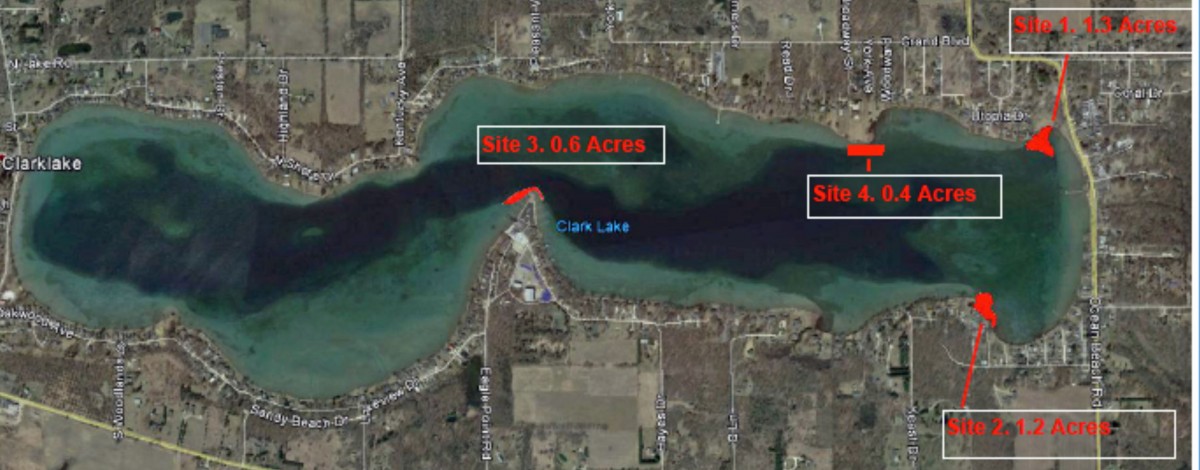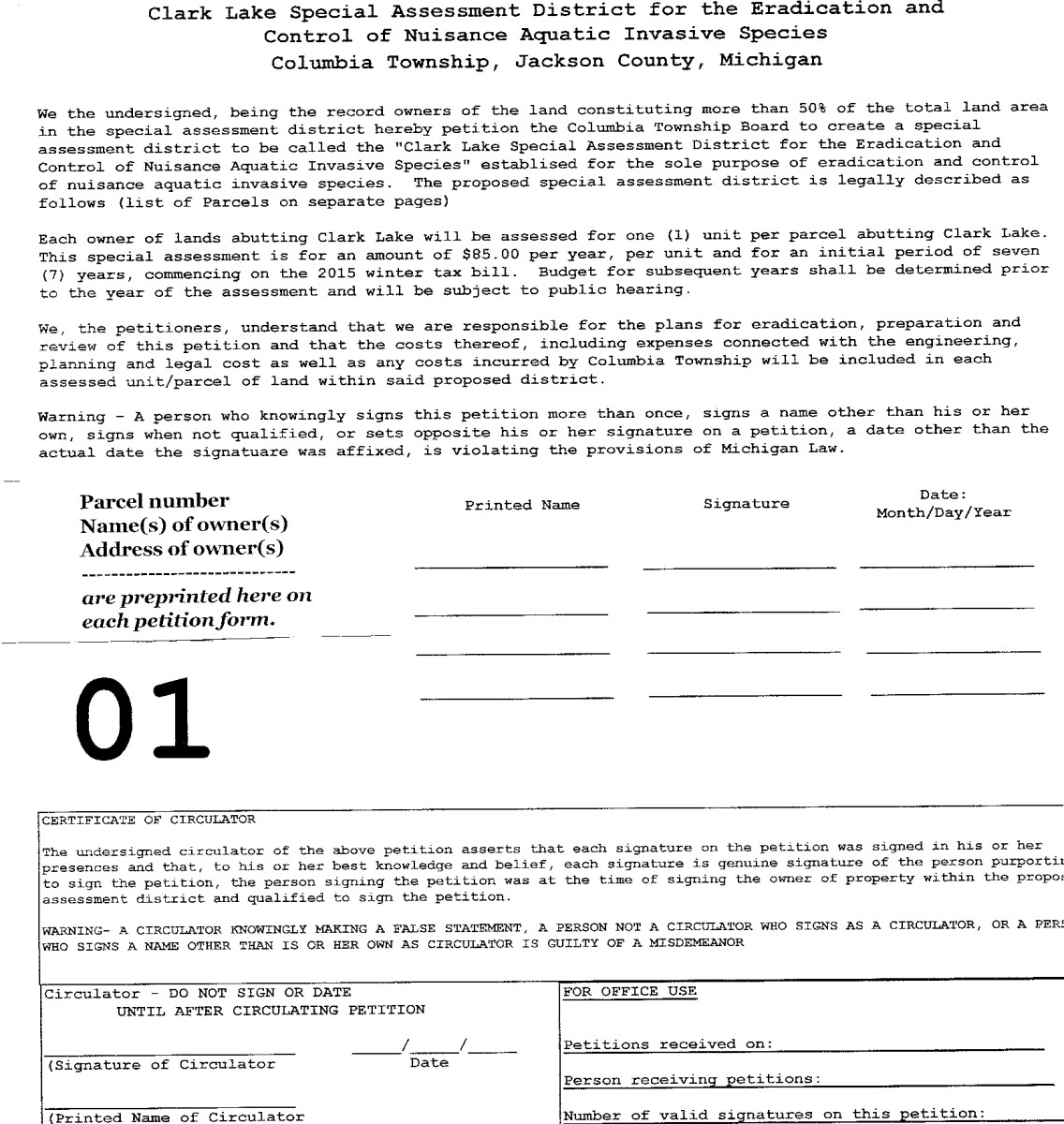This spring four areas of the much larger 20-arces of hybrid Eurasian milfoil (HEWM) in Clark Lake will be treated. Today, Steve Hansen, a fisheries biologist from Professional Lake Management, toured Clark Lake to determine the current state of HEWM at the four sites. His review revealed that the plants must mature a bit more for treatment to be effective. He expects that treatment will take place in about two weeks, after the Memorial Day weekend. According to Hansen, water temperature and weather conditions are factors. Lower temperatures, like today, slows down the growth of the plants.
The treatment of the four areas this spring is supported by donations to the Clark Lake Spirit Foundation.To legally treat the remainder of the 20 acres, it’s necessary to set up a Special Assessment District (SAD). The petition drive that began this weekend is a first step. The SAD will have a 7 year term, beginning in 2016. The cost will be added to property taxes collected by the Township and will be $85 for the first year. That cost may decline in future years if the experience of Clark Lake parallels some other area lakes.
As you are likely aware, DNA evidence confirms the presence in Clark Lake of this fast spreading weed. Other lakes that did not stop this weed found that it severely curtailed recreational use, destroyed wildlife habitat, and was detrimental to property values.
Quick action works best in thwarting the advance of this aquatic invader. Your signature on the petition will indicate that you support the formation of a SAD.
Those knocking on doors report that many lakefront property owners are not yet at the lake. If you are one of them and wish to support this activity by signing the petition, you can request that a petition be emailed to you. For the petition to be counted by the Township, the following steps should be taken.
There is pre-printed petition form for each piece of lakefront property that lists the owner(s). Each owner (or owners) should sign in the appropriate location on the form. The signing must be witnessed by someone known as a “circulator”. The circulator must be someone other than the owner(s). After the circulator witnesses the signature of the owner(s), he or she prints and signs his or her name and address. The completed form should then be returned by US Mail. To initiate this process, your request should be emailed to clarklakespirit@gmail.com.
An info sheet covering frequently asked questions has been put together and will soon be available in print. Below, you can preview the FAQ section.
FAQs
Who may sign the petition?
Only lakefront property owners. If a property is held jointly, all owners must sign for that piece of property or “parcel.” It is not necessary to be a Michigan resident to sign the petition.
What does the circulator of the petition do?
The circulator takes the petition to lakefront property owners and asks them to sign it. The circulator must witness the signing, and confirm this by signing his or her name in the appropriate section of the form. There are no requirements of residency or ownership to be a circulator, but he or she must be someone other than the signer of the petition.
What does the petition look like?
There is a separate sheet for each lakefront property. The form includes the parcel ID number, the name(s), and address of the owner(s). Scroll down to view a sample petition.
How do I pay the $85 fee?
It will be included as a separate line item on property tax bills of lakefront owners.
How do you treat HEWM?
The two herbicides that are typically used target the invasive weeds, but do not affect native plants. Their use is approved by several agencies including the DNR/DEQ and EPA. Neither the American Cancer Society nor U.S. Toxicology Program has listed the herbicides as a carcinogen. There are no known detrimental effects to humans, pets and wildlife. All treatments will be applied by professionals and done by permit with all rules rigorously observed.
What about swimming in the lake after the treatment?
The herbicides are in common use—you may have some in your garage right now. If you mistakenly got a small amount on you while spraying dandelions, you’d likely have a far greater dosage than from swimming in the lake right after treatment. There is a 24-hour swimming restriction that applies only within 100 feet of the treatment areas.
Will my well be contaminated?
No. Testing has shown no trace of contaminants from wells in treatment areas.
How long do the herbicides last in the water?
Renovate, the herbicide used within 250 feet of shorelines and 2,4-D which will be used more than 250 feet from shore may be detectable for several days, up to a week. Though still detectable, the concentrations are greatly reduced from the target concentrations. These two herbicides have no irrigation restrictions for lawns, but they do for some ornamentals. The applicator indicates that they are required to post 120 days for Renovate for ornamentals, but “our sampling has shown within 3 to 5 days after treatment it is non-detectable.”
Will Roundup be used in Clark Lake?
Roundup will not be used in Clark Lake.
Can herbicides be applied early in the season before the lake is being used for recreation?
Spring is the ideal time for application. HEWM is one of the first plants to grow in the spring and begins to spread before native plants start their growth cycle. This allows for easier targeting. Follow up treatments may occur later in the season.
What’s the worst downside of using herbicides in the lake?
It’s possible that treatment will not find every plant. One tiny stem or leaf can generate millions of new plants. This suggests the need for ongoing treatment. After treating all areas of known infestation, experience shows that the degree of infestation declines markedly. For that reason, subsequent treatments can also be greatly reduced. Devils and Round Lakes recently found less need for treatment, and costs to property owners were reduced (read newspaper article).
Aren’t there solutions other than herbicides?
Many other lakes in our region have faced the same problem. Clark Lake is benefiting from their experience. The Committee exhaustively researched solutions that have been tried, and their effectiveness (scroll down under Invasive Weeds for more detail). Here’s a quick summary:
• Harvesting (cutting) – This is the worst solution; cuttings will cause many more plants to propagate.
• Weevils that eat Eurasian milfoil – This was found to be ineffective and the weevils are no longer distributed.
• Sterilized carp – This is illegal in Michigan.
• Suction harvesting – With divers removing plants by hand, there are risks that splinters will cause spreading and roots left behind will reestablish the plant. To remove 20 acres by divers would not be possible in one season, and costs would be exorbitant.
• Mats – the DNR/DEQ permits placement only in small areas, and this would cover only a minute fraction of the 20 acres. Mats are known either to float away causing navigational hazards or to be become mired in muck. Regulations require that they must also be periodically removed. Once removed the invasive weeds reestablish themselves.
• Aeration – Installing electrically operated bubblers in a lake as deep as Clark Lake in all the affected areas would be a logistical nightmare–and very costly.
Since invasive weeds can enter the lake by boats that have been elsewhere, shouldn’t there be hoses at boat launches and a requirement to wash boats before they go into the lake?
Unfortunately this worthwhile idea presents both infrastructure and enforcement challenges. Runoff from the boat washing must be collected, and there are strict rules in transporting it. It’s important to note that HEWM is already established and no amount of boat washing will diminish its ever growing presence in Clark Lake. HEWM also arrives through visiting wildlife. Geese that have been at another lake in the morning may visit Clark Lake in the afternoon. The “results” of their HEWM breakfast are then deposited in Clark Lake. That’s enough to start new colonies of HEWM.
Is there any way to control public boat access to the lake, and shouldn’t people who do use the lake be required to help pay for weed control?
This is a question for Columbia Township, Jackson County and the DEQ. It’s beyond the scope of the Committee.
Once HEWM is treated, what happens to the resulting biomass? Won’t this create more muck?
By not treating HEWM, there will be much more of it; and therefore, more muck. Early treatment will minimize the amount of biomass that sinks to the bottom.
Zebra mussels came and went. Won’t the same thing happen to HEWM?
The decline of zebra mussels was caused by a reduction of nutrients in the water that correlates with the installation of sewers. The growing number of zebra mussels also reduced the nutrient level forcing a self-correction of their numbers. HEWM is completely different. From the study of infested lakes, no evidence suggests that it departs on its own; it only gets worse. HEWM creates a level of density that curtails boating, destroys wildlife habitat and reduces property values. One report said that ducks walked on top of infestations; another eyewitness watched muskrats, not swimming through it, but walking on top of it. Try running a boat through the infestation around the County Park at the east end. It’s a no-go.
Do fertilizers used by some residents cause the weeds to propagate?
Fertilizer encourages the growth of all aquatic plant life, should it wash into the lake. But eliminating fertilizer will not stop the spread of HEWM.
What water depths does HEWM grow in?
HEWM will grow in 20 feet of water right up to the shoreline.
What has been done to inform the public?
The topic has been covered thoroughly on this website. A public information meeting was held in the Columbia High School auditorium in December 2014. About 90 residents attended, asked questions and made comments. After the presentation and Q&A, a straw vote revealed nearly unanimous support for the proposed treatment. At the conclusion of the meeting, a member of the audience, who has a 70 year history at the lake, rose and made this comment: “I don’t like the idea of using chemicals in the lake, but I like even less the idea of losing the lake that we know–therefore I support the treatment program.” As this was being said, heads nodded in agreement, followed by applause.












